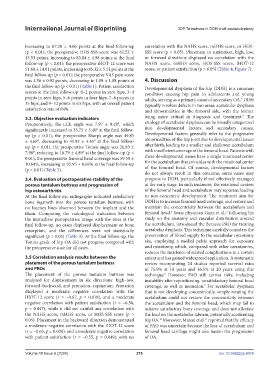Page 227 - IJB-10-6
P. 227
International Journal of Bioprinting 3DP Ta buttress in DDH shelf acetabuloplasty
increasing to 87.20 ± 4.06 points at the final follow-up correlation with the NAHS score, mHHS score, or HOS-
(p < 0.01); the preoperative HOS-SSS score was 62.52 ± SSS score (p > 0.05). Placement in supination, high, low,
13.53 points, increasing to 83.84 ± 4.98 points at the final or forward directions displayed no correlation with the
follow-up (p < 0.01); the preoperative iHOT-12 score was NAHS score, mHHS score, HOS-SSS score, iHOT-12
51.60 ± 14.01 points, increasing to 85.32 ± 5.51 points at the score, or patient satisfaction (p > 0.05) (Table 4; Figure 7).
final follow-up (p < 0.01); the preoperative VAS pain score
was 4.56 ± 0.92 points, decreasing to 1.08 ± 1.08 points at 4. Discussion
the final follow-up (p < 0.01) (Table 1). Patient satisfaction Developmental dysplasia of the hip (DDH) is a common
scores at the final follow-up: 0–2 points in zero hips, 3–4 condition causing hip pain in adolescents and young
points in zero hips, 5–6 points in four hips, 7–8 points in adults, serving as a primary cause of secondary OA. DDH
5
15 hips, and 9–10 points in six hips, with an overall patient typically involves defects in two areas: acetabular dysplasia
satisfaction rate of 84%. and abnormalities in the femoral side, with the former
6
3.3. Objective evaluation indicators being more critical in diagnosis and treatment. The
Preoperatively, the LCE angle was 7.97 ± 9.48°, which etiology of acetabular dysplasia can be broadly categorized
significantly increased to 35.75 ± 5.40° at the final follow- into developmental factors and secondary causes.
up (p < 0.01); the preoperative Sharp’s angle was 49.85 Developmental factors generally refer to the progressive
± 5.68°, decreasing to 41.92 ± 4.45° at the final follow- abnormalities of the hip joint due to developmental issues
up (p < 0.01); the preoperative Tonnis angle was 26.83 ± after birth, leading to a smaller and shallower acetabulum
7.98°, reducing to 16.79 ± 4.89° at the final follow-up (p < with insufficient coverage of the femoral head. Patients with
0.01); the preoperative femoral head coverage was 59.59 ± these developmental issues have a single rotational center
10.64%, increasing to 95.95 ± 8.68% at the final follow-up for the acetabulum that coincides with the rotational center
(p < 0.01) (Table 2). of the femoral head. Of course, developmental factors
do not always result in this outcome; some cases may
3.4. Evaluation of postoperative stability of the progress to DDH, particularly if not effectively managed
porous tantalum buttress and progression of at the early stage. In such instances, the rotational centers
hip osteoarthritis of the femoral head and acetabulum may separate, leading
At the final follow-up, radiographs indicated satisfactory to non-concentric development. The treatment aim for
bone ingrowth into the porous tantalum buttress, with DDH is to increase femoral head coverage, and restore and
no lucency lines observed between the implant and the maintain the concentricity between the acetabulum and
5
7
ilium. Comparing the radiological indicators between femoral head. Swiss physician Ganz et al., following his
the immediate postoperative image with the ones at the study on the anatomy and vascular distribution around
final follow-up, no cases displayed displacement or bone the acetabulum, introduced the Bernese PAO for treating
resorption, and the differences were not statistically acetabular dysplasia. This technique carefully considers the
significant (p > 0.05) (Table 3). At the final follow-up, the preservation of blood supply to the acetabular osteotomy
Tonnis grade of hip OA did not progress compared with site, employing a medial pelvis approach for exposure
the preoperative state for all cases. and osteotomy, which, compared with other osteotomies,
reduces the incidence of related complications to a certain
3.5 Correlation analysis results between the extent and has gained widespread application. A systematic
placement of the porous tantalum buttress review incorporating 24 studies reported survival rates
and PROs of 75.9% at 10 years and 36.5% at 20 years using this
The placement of the porous tantalum buttress was technique. However, PAO still carries risks, including
8
analyzed for displacement in six directions: high–low, instability after repositioning, unsatisfactory femoral head
forward–backward, and pronation–supination. Pronation coverage, as well as nonunion. For acetabular dysplasia
9
displayed a moderate negative correlation with the that is not developing concentrically, simply rotating the
iHOT-12 score (r = −0.67, p = 0.018), and a moderate acetabulum could not restore the concentricity between
negative correlation with patient satisfaction (r = −0.58, the acetabulum and the femoral head, which may fail to
p = 0.047); while it did not exhibit any correlation with achieve satisfactory bony coverage and does not alleviate
the NAHS score, mHHS score, or HOS-SSS score (p > the load on the acetabular labrum, potentially accelerating
0.05). Placement in the backward direction demonstrated hip OA. Moreover, Matsui et al. reported that the efficacy
10
11
a moderate negative correlation with the iHOT-12 score of PAO was uncertain because the loss of acetabulum and
(r = −0.63, p = 0.020), and a moderate negative correlation femoral head cartilage might also hasten the progression
with patient satisfaction (r = −0.55, p = 0.049); with no of OA.
Volume 10 Issue 6 (2024) 219 doi: 10.36922/ijb.4074

